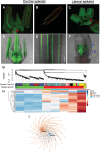HOMEOBOX2, the paralog of SIX-ROWED SPIKE1/HOMEOBOX1, is dispensable for barley spikelet development
- PMID: 38366171
- PMCID: PMC11358255
- DOI: 10.1093/jxb/erae044
HOMEOBOX2, the paralog of SIX-ROWED SPIKE1/HOMEOBOX1, is dispensable for barley spikelet development
Abstract
The HD-ZIP class I transcription factor Homeobox 1 (HvHOX1), also known as Vulgare Row-type Spike 1 (VRS1) or Six-rowed Spike 1, regulates lateral spikelet fertility in barley (Hordeum vulgare L.). It was shown that HvHOX1 has a high expression only in lateral spikelets, while its paralog HvHOX2 was found to be expressed in different plant organs. Yet, the mechanistic functions of HvHOX1 and HvHOX2 during spikelet development are still fragmentary. Here, we show that compared with HvHOX1, HvHOX2 is more highly conserved across different barley genotypes and Hordeum species, hinting at a possibly vital but still unclarified biological role. Using bimolecular fluorescence complementation, DNA-binding, and transactivation assays, we validate that HvHOX1 and HvHOX2 are bona fide transcriptional activators that may potentially heterodimerize. Accordingly, both genes exhibit similar spatiotemporal expression patterns during spike development and growth, albeit their mRNA levels differ quantitatively. We show that HvHOX1 delays the lateral spikelet meristem differentiation and affects fertility by aborting the reproductive organs. Interestingly, the ancestral relationship of the two genes inferred from their co-expressed gene networks suggested that HvHOX1 and HvHOX2 might play a similar role during barley spikelet development. However, CRISPR-derived mutants of HvHOX1 and HvHOX2 demonstrated the suppressive role of HvHOX1 on lateral spikelets, while the loss of HvHOX2 does not influence spikelet development. Collectively, our study shows that through the suppression of reproductive organs, lateral spikelet fertility is regulated by HvHOX1, whereas HvHOX2 is dispensable for spikelet development in barley.
Keywords: Anther and pistil development; CRISPR; HD-ZIP class I transcription factors; barley (Hordeum vulgare); gene duplication; inflorescence architecture; nucleotide diversity; spikelet fertility.
© The Author(s) 2024. Published by Oxford University Press on behalf of the Society for Experimental Biology.
Conflict of interest statement
The authors declare no conflict of interest.
Figures





Similar articles
-
Six-rowed spike4 (Vrs4) controls spikelet determinacy and row-type in barley.Proc Natl Acad Sci U S A. 2013 Aug 6;110(32):13198-203. doi: 10.1073/pnas.1221950110. Epub 2013 Jul 22. Proc Natl Acad Sci U S A. 2013. PMID: 23878219 Free PMC article.
-
Duplication of a well-conserved homeodomain-leucine zipper transcription factor gene in barley generates a copy with more specific functions.Funct Integr Genomics. 2010 Mar;10(1):123-33. doi: 10.1007/s10142-009-0134-y. Epub 2009 Aug 26. Funct Integr Genomics. 2010. PMID: 19707806 Free PMC article.
-
Divergence of expression pattern contributed to neofunctionalization of duplicated HD-Zip I transcription factor in barley.New Phytol. 2013 Feb;197(3):939-948. doi: 10.1111/nph.12068. New Phytol. 2013. PMID: 23293955
-
The Black Book of Psychotropic Dosing and Monitoring.Psychopharmacol Bull. 2024 Jul 8;54(3):8-59. Psychopharmacol Bull. 2024. PMID: 38993656 Free PMC article. Review.
-
Home treatment for mental health problems: a systematic review.Health Technol Assess. 2001;5(15):1-139. doi: 10.3310/hta5150. Health Technol Assess. 2001. PMID: 11532236
Cited by
-
Anatomical insights into the vascular layout of the barley rachis: implications for transport and spikelet connection.Ann Bot. 2024 May 13;133(7):983-996. doi: 10.1093/aob/mcae025. Ann Bot. 2024. PMID: 38407464 Free PMC article.
References
-
- Bonnett OT. 1935. The development of the barley spike. Journal of Agricultural Research 51, 451–457.
-
- Capella M, Re DA, Arce AL, Chan RL. 2014. Plant homeodomain-leucine zipper I transcription factors exhibit different functional AHA motifs that selectively interact with TBP or/and TFIIB. Plant Cell Reports 33, 955–967. - PubMed
Publication types
MeSH terms
Grants and funding
LinkOut - more resources
Full Text Sources
Research Materials

